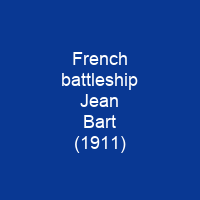Jean Bart was the second of four Courbet-class battleships built for the French Navy. She spent the war in the Mediterranean and helped to sink the Austro-Hungarian protected cruiser Zenta on 16 August 1914. After the war, she and her sister ship France participated in the occupation of Constantinople. She was partially modernised twice during the 1920s, but was deemed to be in too poor condition to be refitted again in the 1930s. She became a training ship in 1934 and was then disarmed and hulked as an accommodation ship in 1935–1936 in Toulon. The Germans captured her in 1942 and used her for testing large shaped charge warheads. In 1944, she was sunk by Allied bombing in 1944
About French battleship Jean Bart (1911) in brief

The ships were 166 metres long overall and had a beam of 27 metres and a mean draught of 9. 04 metres. They displaced 23,475 tonnes at normal load and 25,579 tonnes at deep load. Their crew numbered 1,115 men as a private ship and increased to 1,187 when serving as a flagship. They carried enough coal and fuel oil to give them a range of 4,200 nautical miles at a speed of 10 knots. The ships’ waterline belt ranged in thickness from 140 to 250 mm and was thickest amidship. The gun turrets were protected by 250–360 millimetres of armour and 160- millimetre plates protected the casemates. The curved armoured deck was 40 mm thick on the flat and 70 mm on the outer slopes. The conning tower had 266 mm thick face and sides. These boilers were coal-burning with auxiliary oil sprayers and were designed to produce 28,000 metric horsepower. The ships had a designed speed of 21 knots. They were powered by two licence-built Parsons steam turbine sets, each driving two propeller shafts using steam provided by 24 Belleville boilers, and could stow 10 mines below decks. The ship launched on 22 September 1913 at a cost of F60,000,000 and was commissioned into the fleet together with her sister France on 19 November 1913.
You want to know more about French battleship Jean Bart (1911)?
This page is based on the article French battleship Jean Bart (1911) published in Wikipedia (as of Dec. 08, 2020) and was automatically summarized using artificial intelligence.







